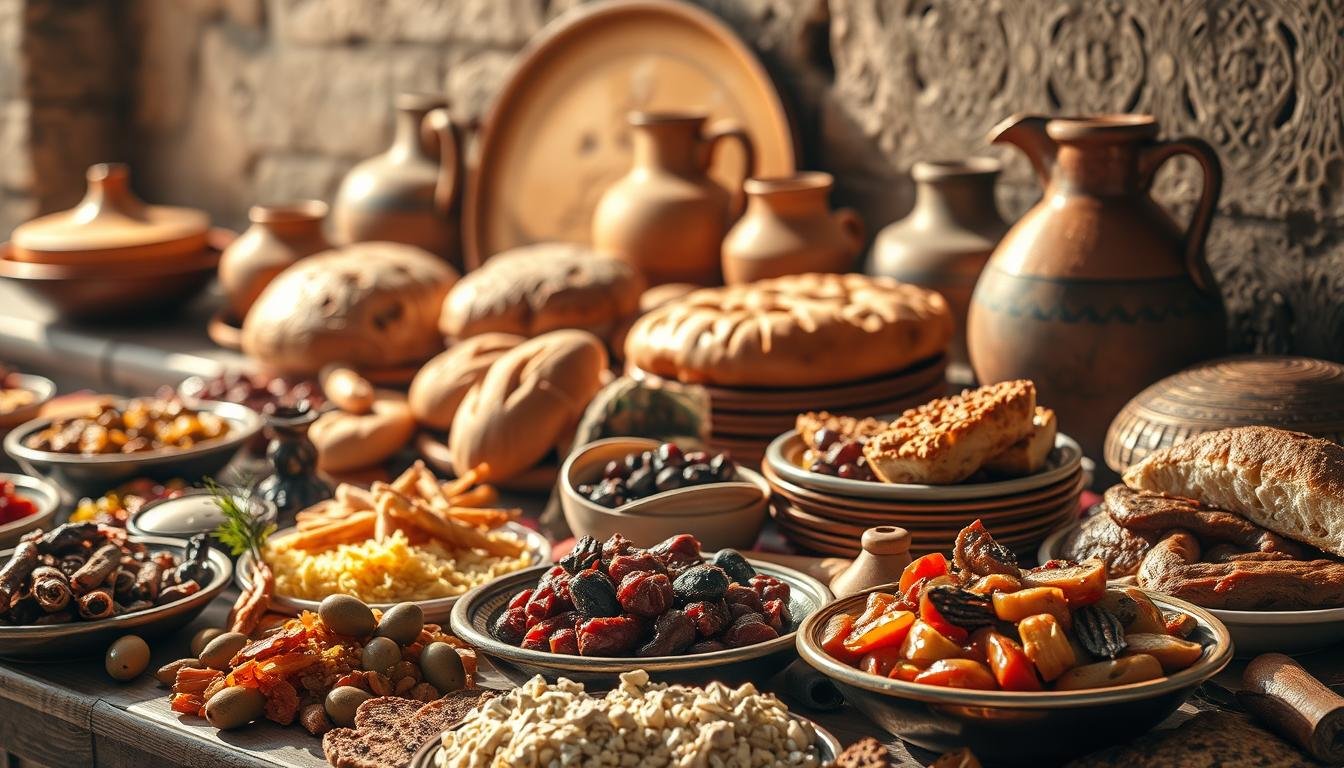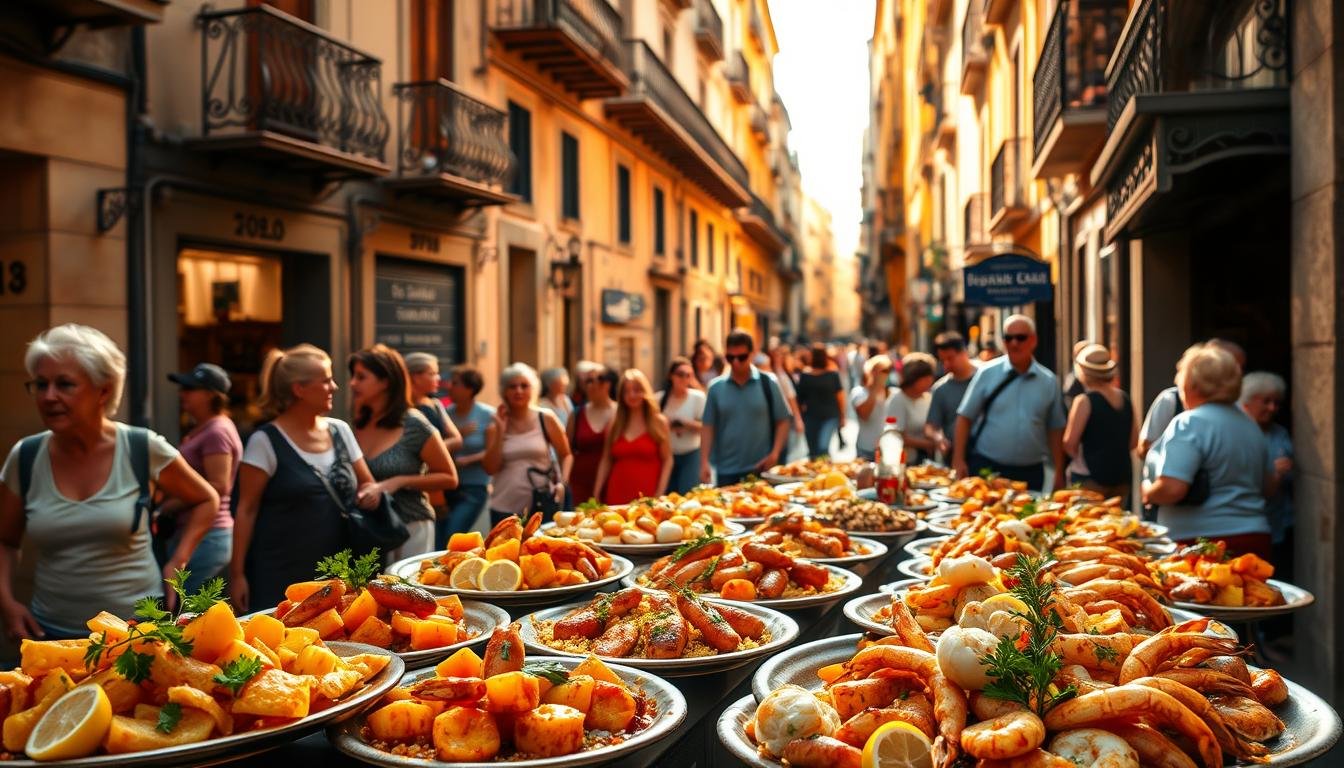
A breathtaking panoramic view of Toledo cityscape featuring the historic Alcazar under a vibrant sky.
Walking through Toledo’s cobblestone streets, you can smell saffron and toasted almonds. It’s a sign of a unique culinary tour in Toledo Spain. Here, Moorish, Jewish, and Christian histories meet, making every dish a story. Your first taste of carcamusa, a stew with cinnamon and pork, shows the city’s rich past.
Toledo’s food is more than just meals. It’s a mix of centuries of cultural exchange. This mix gives Spanish food its unique flavor.
Toledo’s food history is filled with recipes that lasted through empires. In its markets, you can smell cured ham and sweet mazapán de Toledo marzipan. This treat was born in medieval convents.
This city, where different traditions once cooked together, teaches us about diversity. Toledo’s cuisine invites you to taste history itself.
Key Takeaways
- Three cultures food in Toledo blends Moorish spices, Jewish culinary wisdom, and Christian traditions into every bite.
- Exploring Toledo’s cuisine reveals how Spanish gastronomy evolved through 2,000 years of cultural coexistence.
- Iconic dishes like perdiz estofada (partridge stew) and marzipan reflect Toledo’s unique culinary heritage.
- Local eateries preserve centuries-old recipes, making Toledo a must-visit for food history enthusiasts.
- Its food scene offers a deeper connection to Spain’s past than mainstream tourist destinations.
Toledo: A Melting Pot of Flavors Throughout History
Walking through Toledo’s ancient streets, you smell roasted meats and toasted almonds. The city’s Toledo food history is written in its cobblestones and Spanish food traditions. Toledo sits on a hill, a key spot for traders and rulers. They brought ingredients and recipes from the Mediterranean.
Its riverside cliffs once protected against invaders. They also kept culinary practices safe from outside influences. Over time, these traditions blended into something uniquely Toledo’s. Exploring its culinary layers is like peeling back centuries of cultural exchange.
As Spain’s medieval capital, Toledo’s royal kitchens were innovation hubs. They created saffron-infused stews over charcoal fires. Monasteries and Moorish markets merged their recipes, shaping historical gastronomy..
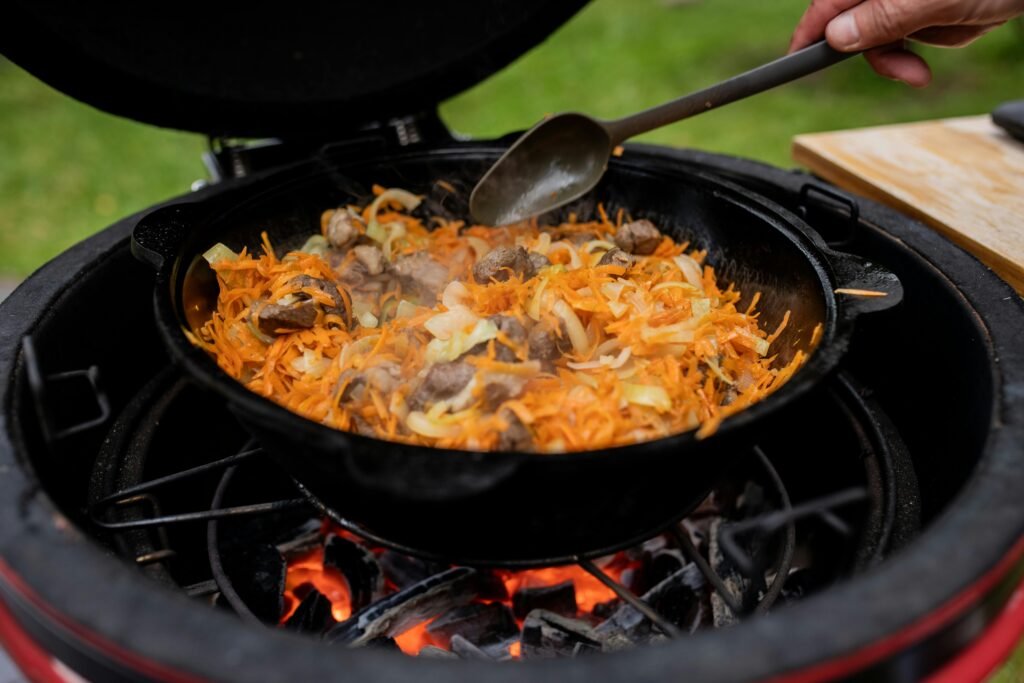
Delicious beef with vegetables sizzling in a cast iron skillet over an open flame, outdoor cooking style
The melting pot cuisine here isn’t by chance. It is shaped by necessity and diplomacy.
A table of survival:
| Culture | Signature Dish | Preservation Method |
|---|---|---|
| Moorish | Carcamusa (spiced pork stew) | Secret family recipes passed orally |
| Jewish | Almendrados (almond cakes) | Hidden symbols in baking techniques |
| Christian | Marzipan sculptures | Conventual monastic recipes |
Let your senses come alive in a hidden plaza. At La Corte de Carlos, a 16th-century mazapán recipe taste like sun-dried almonds. The mix of cultures here is not just history—it’s alive in every bite.
Moorish Influences: Spices, Techniques and Lasting Legacy
Walking Toledo’s narrow streets, you can smell the past. The scent of saffron and cumin fills the air. It’s a reminder of Moorish cuisine in Spain that made this city’s heart.
In local markets, spices add color to the scene. Toledo saffron dishes start with saffron threads as red as sunset. Cumin and cinnamon give cochinillo asado its unique taste. These flavors are more than ingredients; they’re family treasures.
Almond desserts in Toledo tell a story of their own. At Casa de los Reyes, almonds turn into almendrados—crisp, honey-glazed treats. The Islamic influence Spanish food is clear here, with almonds and citrus from North Africa. Their mantecados (almond cookies) have layers of butter, a tribute to the past.

Close-up of assorted French macarons in a rustic bowl.
- Almendrados: Honey-kissed almond pastries
- Mantecados: Butter-rich cookies
- Bizcochos de naranja: Orange-scented almond cakes
Slow cooking is a key part of Moorish cooking techniques today. Clay pots simmer stews for hours, reminding you of ancient ways. Chefs use copper tagines to blend flavors, creating magic in the kitchen.
Toledo’s food scene is a tribute to its Moorish past. Every dish connects us to the past, showing that some traditions are best experienced, not just remembered.
Jewish Culinary Traditions: Hidden Gems in Toledo’s Food Scene
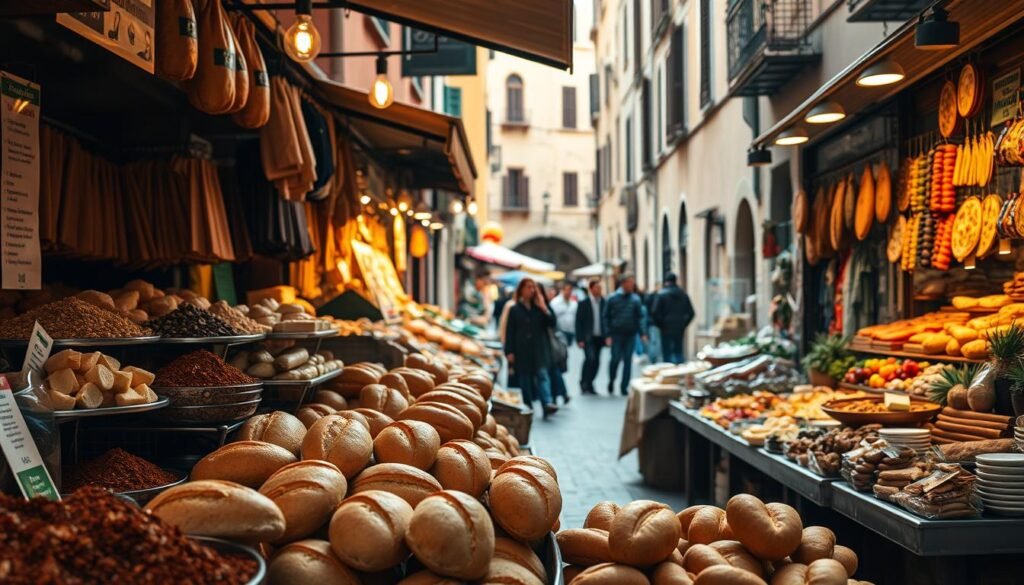
Walking through Toledo’s Judería, you’ll feel the past in every step. The smell of almonds and spices came from kitchens. It was a reminder of a culture almost lost.
Here, Sephardic cuisine Spain comes alive in dishes like huevos haminados. These slow-roasted eggs show Jewish food in Toledo is very much alive. Flavors from exile and return now fill menus at places like La Corte Nueva.
At the heart of these traditions are kosher dishes from Spain. Eggplant filled with pine nuts and currants is a taste of 14th-century cookbooks. It’s sweet and has a hint of saffron. A local baker said, “Our mazapán holds memories.” Her almond pastries, with rosewater, remind us of Toledo’s food vendors.
“These flavors are our ancestors’ letters home,” said chef Ana García, reviving dishes in her Judería restaurant. “They teach us to taste history.”
| Dish | Tradition | Modern Twist |
|---|---|---|
| Huevos Haminados | Sabbath-ready eggs | Served with date molasses at Casa María |
| Berenjenas con miel | Honey-glazed eggplant | Paired with quince jelly at El Legado |
Exploring these flavors is like finding treasure. At La Sinagoga, a 15th-century space, have the torta de aceite. It’s a simple olive-oil cake that reminds you of ancient fast-day recipes. These dishes, once hidden, now let you taste a culture’s strength. Every bite connects the past to the present, showing Jewish traditions flavor Toledo’s heart.
Christian Contributions: From Monastery Kitchens to Iconic Dishes
Walking through Toledo’s cobblestone streets, you’ll catch the scent of almonds near historic convents. It’s here that Toledo marzipan is born—a sweet alchemy from cloistered kitchens. Monastery cooks, driven by necessity and devotion, turned simple ingredients into timeless treats.
At Convento de Santo Tomé, taste convent sweets Toledo that melt in your mouth. Their recipes have been kept secret for centuries. The nuns perfected the mix of sugar and blanched almonds, making Toledo marzipan into shapes like saints and stars.
The Spanish monastery cuisine goes beyond sweets. In rustic taverns, Toledo game dishes show Castilian roots. Venison stews simmered with rosemary or roasted partridge stuffed with wild mushrooms reflect the region’s hunting heritage.
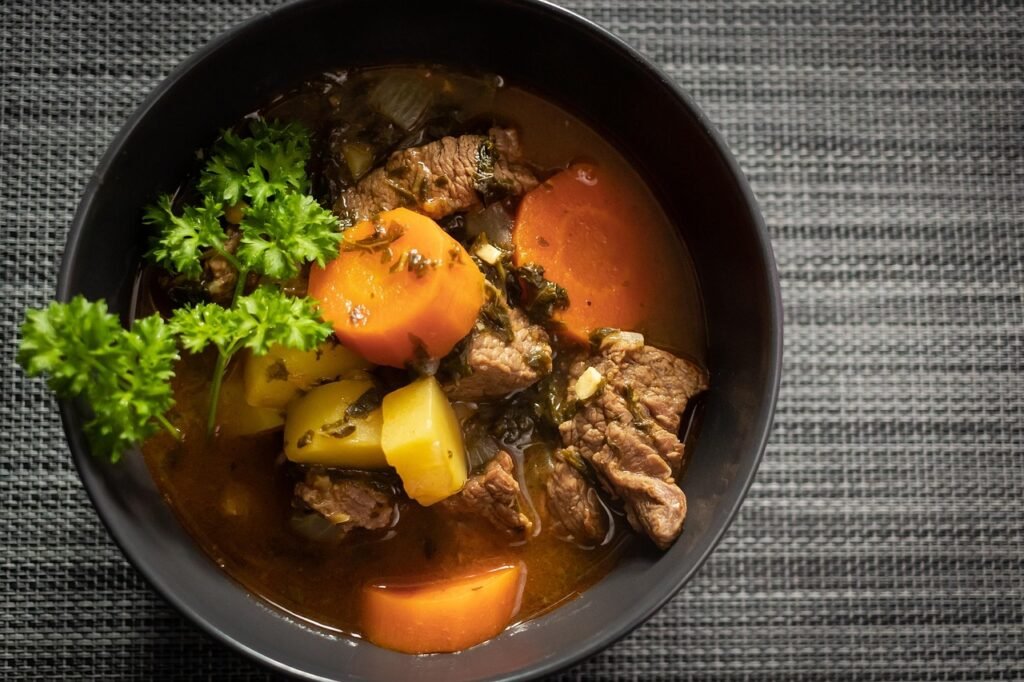
Tasty venison stew slowly simmered with carrots, potatoes, and onions.
Chefs today honor these traditions while adding their own twist. A server said, “Our ancestors hunted these lands; we honor them without losing their essence.”
“Fasting periods inspired creativity,” said a local historian. “Lent called for cod dishes wrapped in vine leaves, while Easter brought buttery hornazo pastries.”
Catholic food traditions shape Toledo’s seasons. During Semana Santa, bakeries are filled with yolk-rich mazapán figurines. These rituals are alive, not just relics. Every bite of convent sweets Toledo or a game dish tells a story of faith and survival.
It shows that tradition and innovation can meet on the same plate.
Must-Try Dishes That Define Toledo’s Unique Gastronomic Identity
Exploring Toledo’s kitchens is like stepping back in time. Here, three dishes stand out. They show the city’s rich history and modern twist. Let’s dive into the flavors every traveler should try.
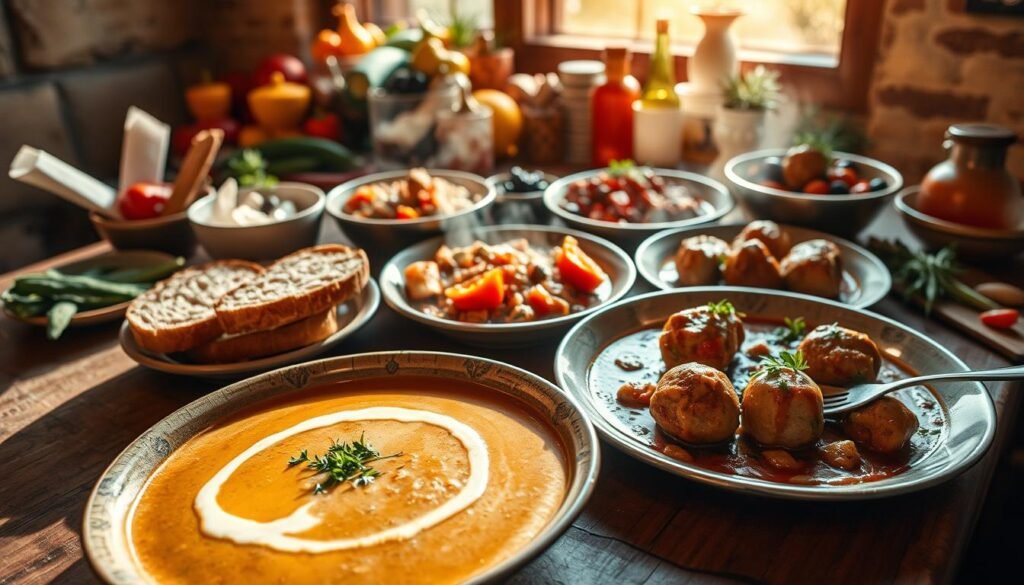
Carcamusa: Toledo’s Signature Stew
In a sunny tavern, you’ll learn about carcamusa from Dona Rosa. She’s a chef with a family tradition. Her stew is made with pork, rosemary, and smoked paprika.
“The sauce must cling to the spoon,” she said, “like a lover’s promise.” Her words remind us of the effort needed for perfection. This is true for her stew and other dishes like Tex-Mex enchiladas.
“The secret’s in the overnight marination,” Dona Rosa insisted, stirring the pot with a wooden spoon worn smooth by decades of use.
Perdiz Estofada: The Partridge Dish That Captivates Gourmands
This Toledo partridge stew turns wild game into a masterpiece. The partridge’s flavor mixes with red wine and a touch of bitter chocolate. It’s a perfect blend.
Local chefs suggest:
- Pair with roasted quince compote for balance
- Visit La Corte Inglesa for autumn’s peak game season
Mazapán de Toledo: Why It Surpasses All Other Marzipan
Mazapán is more than marzipan; it’s a special almondy treat. Maria Elena shows you the secret: toasting Marcona almonds and mixing them with sugar. This makes a smooth paste that’s shaped into sweet figures.
Every bite shows why this sweet treat is the best.
For the real deal, go to La Casa de San Clemente.
The Ultimate Culinary Tour of Toledo Spain: Where to Eat Like a Local
Start your culinary tour of Toledo Spain on cobblestone streets. They tell tales of spice routes and royal feasts. Begin at Café La Pascua, where churros and hot chocolate have been a tradition for 1894.
This place is more than breakfast. It’s a ritual of cinnamon pastries and cocoa so thick, you can hold a spoon in it.
“Press the Manchego wheels—the firmest ones sing with almond undertones.”
Buy pimentón and membrillo, then visit Casa de las Culebras. This best restaurants Toledo spot offers saffron-infused carcamusa in earthenware pots. Across the river, Casa Manuela in the Jewish quarter serves migas con conejo.
Here, crispy breadcrumbs meet rabbit stew under orange trees.
- Morning: Café La Pascua’s chocolate con churros (8:00 AM)
- Noon: San Antonio Market for artisanal ingredients
- Afternoon: Food tour Toledo highlights:
- Casa de las Culebras (Moorish dishes)
- Casa Manuela (Sephardic flavors)
- Mesón de Cervantes (Castilian game meats)
- Evening: Where to eat Toledo for tapas? Try El Sapo for fried callos a la madrileña in a 16th-century cellar.
Finish with mazapán from Pastelería San Clemente. Their almond sweets are made with nuns’ recipes. Arrive by 3 PM to avoid crowds. Let servers guide you to the best taverns.
This is how you taste Toledo’s soul, one bite at a time.
Beyond the Tourist Traps: Hidden Culinary Treasures Only Locals Know
Exploring Toledo’s alleys, you’ll find hidden gems where time stands. Family restaurants Toledo keep traditions alive with recipes passed down. In a sunny kitchen, a grandma cooks stews while her granddaughter chopped garlic. This shows how heritage lives in these cozy places.

Where Recipes Become Family Chronicles
At Casa de la Tía Pilar, a family has cooked for three generations. They fry churros in copper pans, a method from 1890. These places value tradition over looks, serving dishes like judiones with a rich history. Try their secret menu, like almond cod stew, known only to locals.
Tapas as Living History
Smell the grilled chorizo to find Toledo’s hidden taverns. In a dim cellar near the Alcázar, Boquerón offers free-flowing sherry and croquetas de jamón. These spots are simple, with no menus but daily specials on chalkboards.
Markets Where Toledo Breathes
Every Thursday, the Mercado de la Victoria is a feast for the senses. Vendors at local markets Toledo know everyone by name. They slice Iberico ham and offer aceite de oliva virgen extra. Find roscos de Toledo at Panadería La Abuela, baked in wood-fired ovens for 172 years. These markets are more than shops; they’re where Toledo’s flavors come alive.
Wine and Spirits: The Perfect Companions to Toledo’s Rich Cuisine
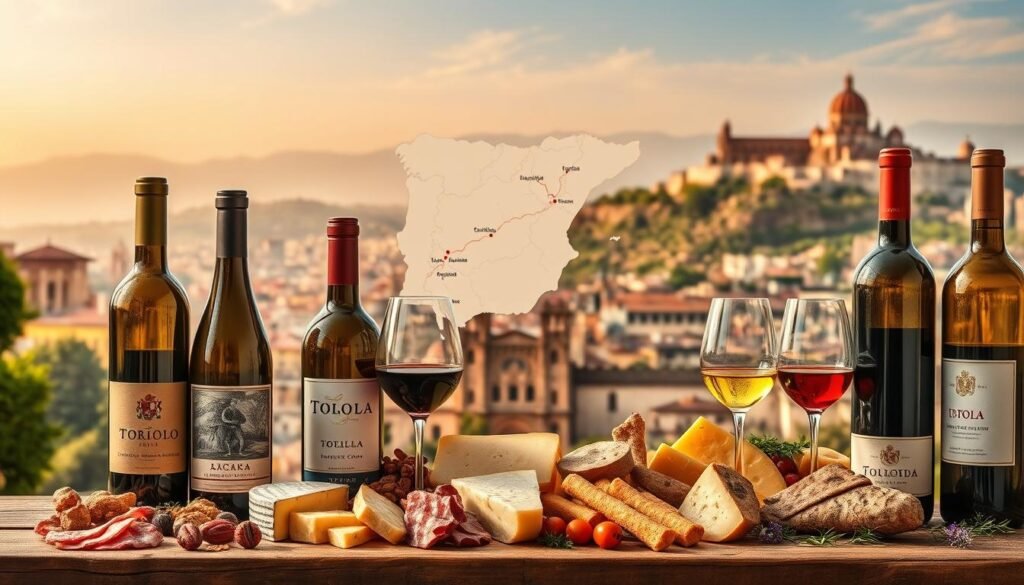
Exploring Toledo’s streets, discover its wines and spirits which are as rich as its history. Nearby La Mancha wines, from Spanish wine regions like Méntrida and La Mancha, pair well with hearty dishes. Aged Tempranillo reds from La Mancha complement game meats, while crisp Airén whites refresh Moorish stews.
“The best traditional Spanish drinks tell a story of place,” said Javier, a sommelier at Bodega San Juan. “Try our house-made anisado—it’s been distilled here for 183 years.”
Toledo local spirits like herb-infused orujo and vermouth made with local herbs enhance any meal. At small tascas, enjoy anise liqueurs that leaves a lasting impression. Young producers are now creating juniper-infused gins, mixing tradition with new ideas.
| Dish | Wine | Spirit |
|---|---|---|
| Carcamusa | La Mancha Tempranillo | Anisado |
| Mazapán con vino | Verdejo white | Citrus-infused orujo |
| Perdiz Estofada | Méntrida Garnacha | Local vermouth |
Pairing these Toledo wine pairings is more than just taste—it’s a journey through history. Visit family-owned bodegas outside the city to taste grapes from Don Quixote’s time. Each sip connects you to the land, showing that tradition and terroir shape every bottle.
Seasonal Specialties: Why Timing Your Visit Matters for Food Enthuasiasts
Visiting Toledo at the right time lets you enjoy its seasonal flavors. The city’s menus change with the seasonal cuisine Toledo Spain. You can try Toledo spring dishes or Toledo winter food that warms your heart. Let’s look at the best times to taste Toledo’s culinary stories.
Spring Delicacies: Freshness After Lent
In spring, Toledo’s markets are filled with wild asparagus and artichokes. Try the taste of hornazo—a pastry with chorizo and egg— as it marks Easter’s end. Chefs mix tender lamb with spring herbs, and Toledo spring dishes like spinach-stuffed peppers show renewal.
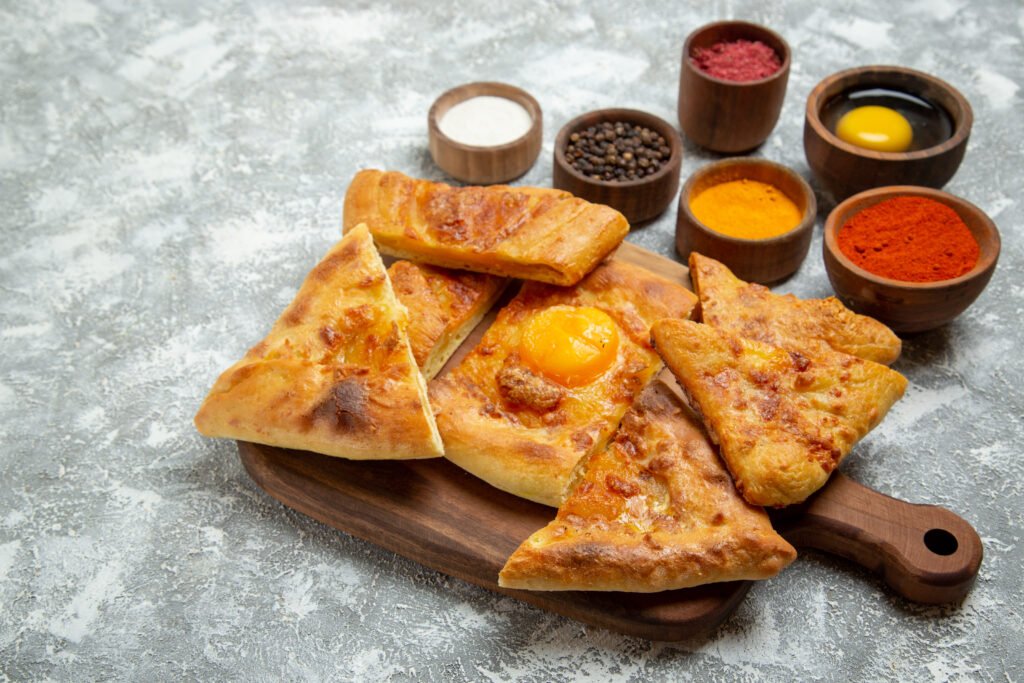
Front view sliced egg bake delicious pastry with seasonings on white space
Don’t miss the Spanish seasonal specialties that celebrate life after Lent.
Summer Food Festivals: Heat and Light
Summer brings Toledo food festivals with outdoor feasts. At Corpus Christi, streets are alive with vermouth bars and grilled sardines. Night markets offer chilled gazpacho and melon with cured ham, a refreshing tradition.
The summer sun highlights Toledo’s vibrant tables when the air is warm.
Fall and Winter: Hearth and Hearth
Winter calls for Toledo winter food like perdiz estofada (partridge stew) cooked for hours. Markets show acorn-fed Iberian hams and roasted chestnuts. At Christmas, convent-style marzipan turns into detailed nativity scenes.
These dishes show Toledo’s soul, proving seasonal cuisine Toledo Spain is worth timing perfectly.
Plan your visit by the seasons. Each month adds a new flavor to Toledo’s feast, always a delight.
Conclusion: Why Toledo Remains Spain’s Most Underrated Culinary Destination
Toledo stands out from Barcelona and Madrid with its rich culinary history. A culinary tour of Toledo Spain shows a city where every dish tells a story. You’ll taste Moorish spices, Jewish traditions, and Christian wisdom in every bite.
Its Toledo gastronomic destination status is rooted in tradition, not trends. Try carcamusa stew or marzipan made by nuns for centuries. These dishes are a taste of Toledo’s heritage.
Toledo is special because it’s not a tourist trap. Here, authentic Spanish food experience is found in family-run kitchens. The Toledo food tourism scene offers dishes like perdiz estofada in old taverns.
This is the best food city Spain for those who value authenticity. Toledo’s charm lies in its quiet streets and hidden flavors. No neon signs or crowded plazas here, just the taste of history.
But Toledo is evolving. Young chefs are adding a modern twist to traditional recipes. This mix of old and new makes Toledo’s food scene vibrant and timeless.
To experience Toledo is to discover Spain’s heart. It’s a journey that reveals the soul of Spain, beyond the usual tourist spots. For those who take their time, Toledo’s flavors offer a journey through time, a story of food and history intertwined.
